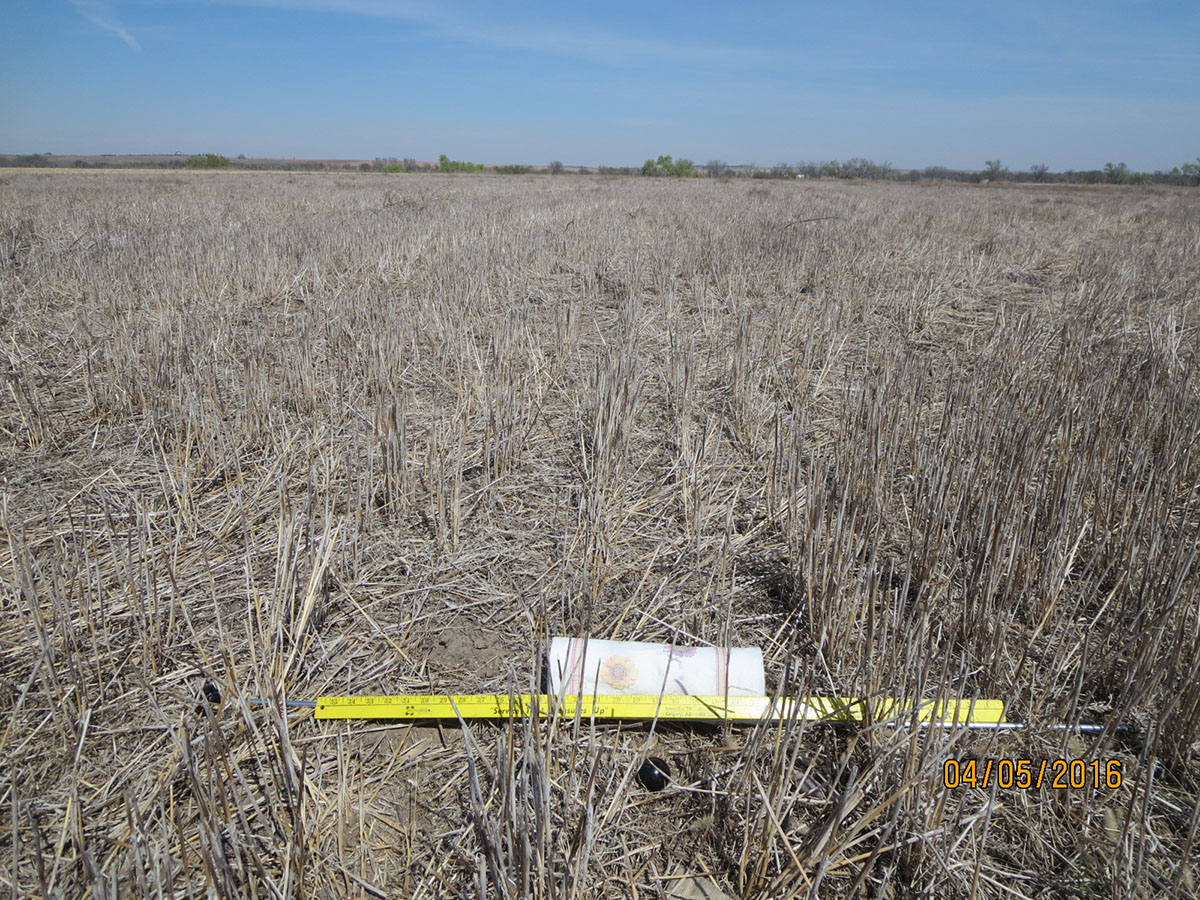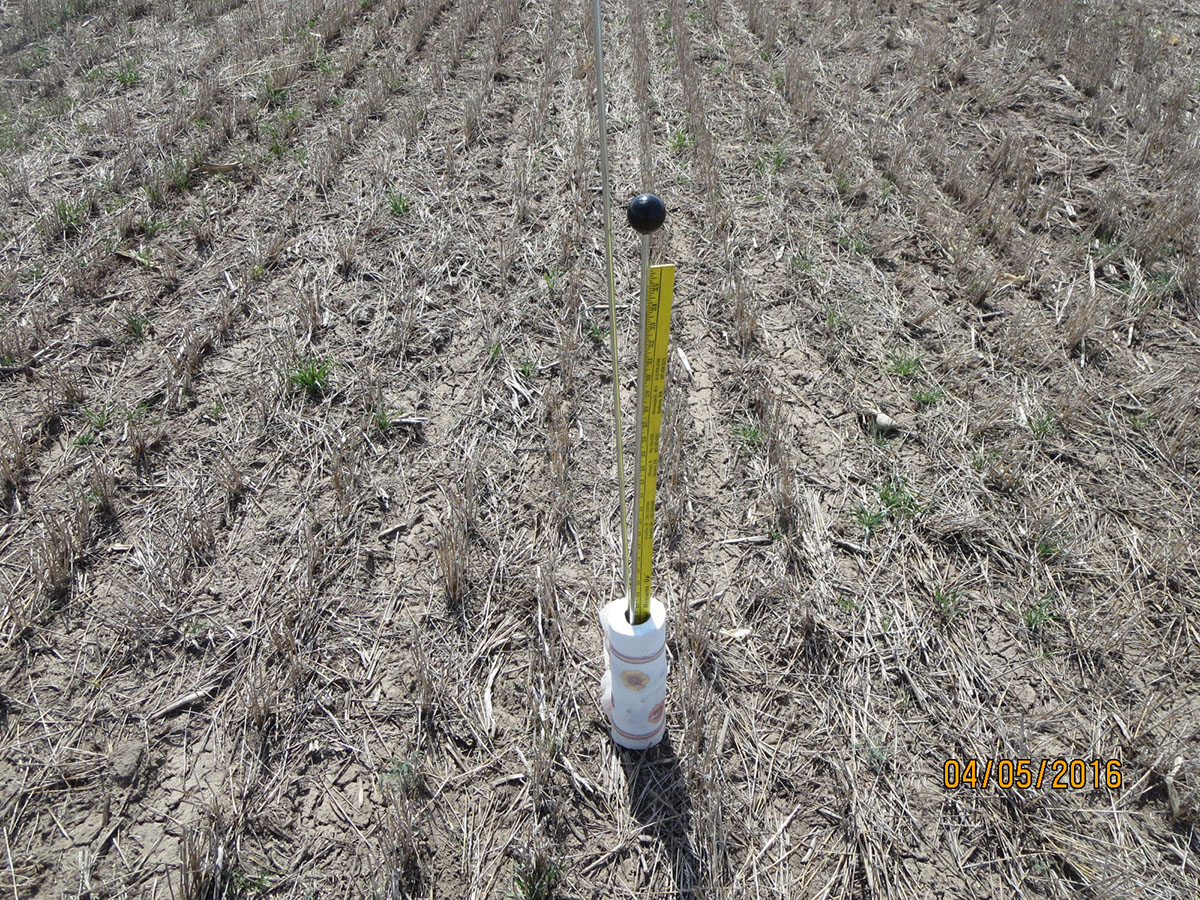Wheat Condition and Soil Moisture Reports
This week the National Drought Monitor rated almost 25% of Nebraska as "abnormally dry," a major change from 0% since Jan. 1. Most of the affected area was along the southern tier of Nebraska counties.
With above normal temperatures in March, wheat has gotten a good start, but may start showing signs of stress if fields don’t receive rain soon. This week the National Agricultural Statistics Service reported Nebraska's winter wheat crop as 3% poor, 37% fair, 51% good, and 9% excellent.
“Wheat variety trial plots are excellent but with the earlier green-up they have used most of the top soil moisture,” reports Bob Klein, Extension Western Nebraska Crops Specialist at the West Central Research and Extension Center in North Platte.

 Figure 2 is a field near Alma with little residue cover and soil water down only to 34 inches.
Figure 2 is a field near Alma with little residue cover and soil water down only to 34 inches.The additional residue on the field shown in Figure 1 also means less evapotranspiration and as much as 3-4 more inches of soil moisture available to the crop.
Robert Tigner, Extension Educator in Red Willow County in southwest Nebraska, reported similarly. “I have not seen any wheat fields showing signs of drought yet. Additional rainfall would be welcome though.” He said some farmers in southwest Nebraska had been applying liquid fertilizer for corn and prepping their planters for the season.
In southeast Nebraska the “weather slowdown has been beneficial to the wheat,” reported Paul Hay, Extension Educator in Gage County. “With open field work days fertilizer was applied in good order and rains in the southern half of the county, where wheat is grown, have it looking good.”
Neither Klein, Tigner, or Hay reported wheat disease.
Soil Moisture in West Central Nebraska
On Tuesday (April 5) Klein conducted a soil moisture survey in southwest Nebraska.
“If you had a good wheat crop in 2015, controlled the weeds in crop and after harvest, and took good care of the crop residue (stripper header was best), you likely have a full or almost full soil water profile. If you didn’t have all or any of the proceeding things, you may have only one-half that amount of soil water,” Klein said. “Also, evaporation during the season will be higher with less crop residue on the field.”
Klein’s April 5 soil moisture survey found:
- Soil water in wheat stubble south of McCook down to 70 inches
- Soil water in ecofallow corn stubble south of McCook down to 30 inches
- Soil water in wheat stubble east of Danbury down to 65 inches
- Soil water in ecofallow corn stubble east of Beaver City down to 33 inches
- Soil water in wheat stubble east of Beaver City down to 72+ inches
- Soil water in dryland corn stubble in Alma down to 35 inches
- Soil water in wheat stubble in wheat cut low with a small amount of crop residue in the Alma area: 34 inches
“The good wheat stubble had 65 to 72 inches plus of soil water,” Klein said, noting 72 inches was considered a full profile. With a good amount of crop residue to help conserve soil moisture, chances for success should be good with dryland corn or dryland sorghum in south central and southwest Nebraska. Also, with 30 inches or more of soil water in corn stubble, growers may consider seeding sorghum or corn in these fields, Klein said.
For more information see Recommended Seeding Rates and Hybrid Selection for Rainfed (Dryland) Corn in Nebraska (G2068). http://extensionpublications.unl.edu/assets/pdf/g2068.pdf
More Field Reports (April 5)
Karen DeBoer, Extension Educator in Cheyenne County: We’ve had a lot of wind and snow, which has caused some stress in our wheat. The leaves are showing some browning from the cold, but the plants haven’t jointed yet and there’s been little damage. There’s some unevenness in stands, likely due to being planted in dry conditions last fall. We haven’t seen any disease yet, although stripe rust has been reported in Colorado. Fields are still drying out after the recent storms and there’s been some weed spraying.
Ron Seymour, Extension Educator in Adams County: Almost all the nitrogen is in, any stalk cutting is done, and growers here are getting ready to plant, just waiting for the calendar to say it’s time. We haven’t received any significant moisture since the Ground Hog Day storm and the soil is fairly dry. Growers would like to see more moisture.
Charles Burr, Extension Water Educator, West Central REC, North Platte: Wheat is starting to green up well and fertilizer is going on. Northern Lincoln County, which benefited from several of the snowstorms, is still wet, while sandy areas in the southern part of the county are dry.
Online Master of Science in Agronomy
With a focus on industry applications and research, the online program is designed with maximum flexibility for today's working professionals.
